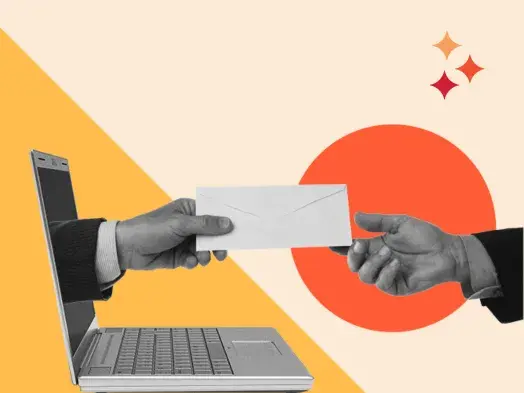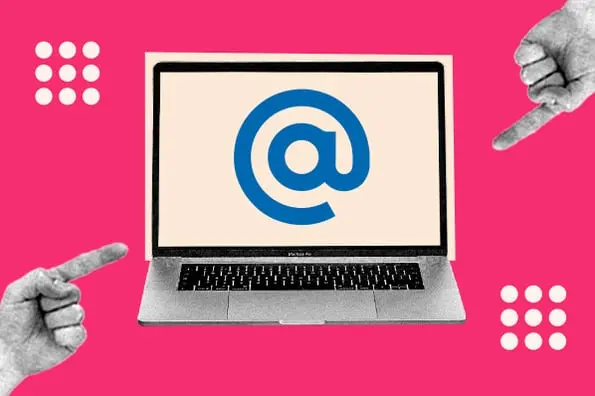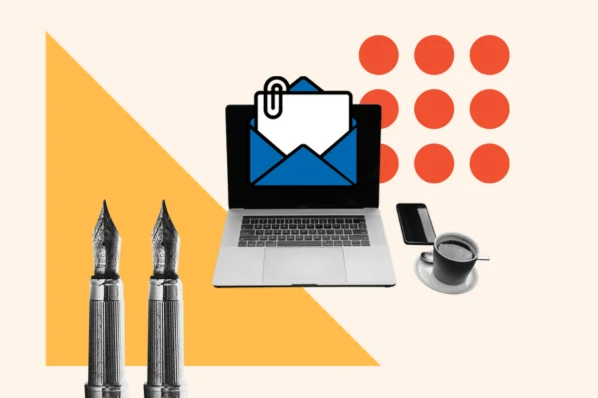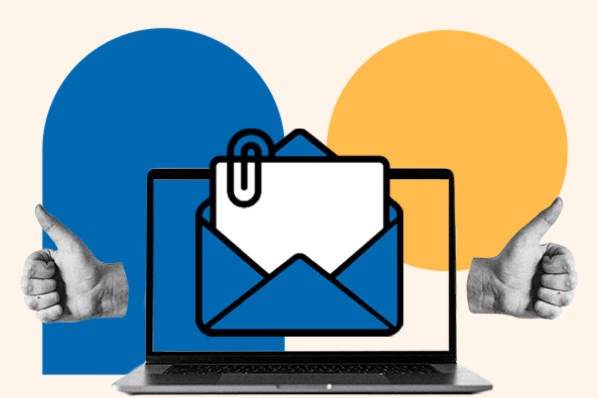Email Marketing Trends for 2024
The first few email trends we‘ll cover have to do with privacy changes and Apple’s latest developments, and the rest are straight from my overcrowded inbox. Let's get started.
1. More Focus on Data Protection and Privacy
64% of online consumers have quit doing business or working with an organization for asking for too much personal information.
Furthermore, 86% of consumers believe companies and organizations collect more information than needed.
As a consumer, I‘ve declined products and services from businesses that seem too eager to gather personal information or indicate they know more about me than I’m comfortable with.
For instance, last year, I contacted a moving company to assist me as I relocated from Florida to Pennsylvania. I gave the company my email address and phone number but ultimately decided not to use movers.
Days after exchanging information, I was bombarded with emails from several other companies advertising their moving services. Somehow, after opting into the initial company's mailing list, I was also added to several others.
The idea of my email and phone number being added to many strange lists that I did not sign up for made me uncomfortable. I immediately unsubscribed from them all — including the first company.
Data protection and privacy are important to consumers, so don't ask for or use more information than you need in your email campaigns. Instead, give email recipients the option to unsubscribe and allow them to change their email preferences.
This improves data privacy, builds trust, and ensures a more engaged email list.
Data protection and privacy aren't just trends; they’re also a legal obligation. Your emails must also comply with the General Data Protection Regulation (GDPR) and follow its guidelines for practices such as cold emails and mailing list building.
2. Less Focus on Open Rates
Speaking of privacy, I can‘t be the only email marketer trying to make sense of my open rates with Apple’s new Mail Privacy Protection (MPP).
In a small survey conducted with Glimpse, we found that almost one-third of marketers list open rates among the top two metrics they track when sending and reporting marketing emails.
However, MPP stops senders from using invisible pixels to collect information about a user, according to Apple. It also prevents senders from knowing when recipients open an email, and it hides their IP address so it can’t be linked to other online activity or be used to determine their location.
In other words, this Apple update prohibits marketers from seeing when and where users open their emails, the device the email is opened on, and the activity used to open it.
Now that open rate is no longer a reliable metric, we must shift our focus to the following metrics to get an accurate read on the success of our marketing emails:
- Click rate - The percentage of recipients who click a link in the email
- Conversion rate - The percentage of recipients who take action, such as making a purchase
- List Growth - How fast you're gaining and losing subscribers
- ROI - Revenue generated for every dollar invested in email marketing
The metrics you track are going to depend on the goals of your email marketing campaign. So, I suggest evaluating what you want your next email marketing campaign to accomplish and tailoring the metrics you track to its purpose.
3. More Niche Content
At HubSpot, we recently started experimenting with newsletters focusing on specific niches within our content.
For example, our newsletter, The Lead, covers the latest news and trends in marketing. The newsletter has featured timely commentary on the “Barbie” and “Oppenheimer” marketing campaigns, Popeye's use of TikTok's “Girl Dinner” trend, and more.
“Our marketing news content really compliments the educational, evergreen content in HubSpot’s repertoire," Principal Marketing Manager and The Lead editor Lestraundra Alfred, explains.
She said, "By showing how companies are applying the latest marketing strategies in real-time, we’re able to keep our audience engaged, taking them behind the scenes of the latest and greatest campaigns to inspire their own work.”
Consider ways to amplify specific brand niches that interest your target audience. For example, if you're a clothing brand, you can send out a newsletter focusing on the latest fashion trends and use it as a chance to showcase products that fit those trends.
4. GIFs
Maybe it‘s the millennial in me, but I still adore GIFs and use them despite Gen-Z’s overall disinterest in them. While GIFs may have fallen out of fashion on social media, I often notice them in my email subscriptions.
For example, the email below is from ThredUp and features a GIF emphasizing the opportunity for email recipients to win $500 of credit with the store.

GIFs are a great way to make your emails stand out and leave an impression on recipients. Use GIFs to emphasize deals and special events or illustrate jokes.
5. Gamification
Who doesn't love games? Many brands entice email subscribers by offering a game-like experience. For example, I received this email from the clothing brand Midnight Hour.
The email announces I‘ve earned 176 points from my past purchase, bringing me closer to the number of points I’d need to win prizes such as free shipping.

Gamify your emails to create a fun, rewarding experience for your subscribers.
To gamify your emails, you can use a point system that customers can redeem for rewards and perks (like Midnight Hour), or you can encourage subscribers to purchase products through email for a chance to win a prize like free onboarding or three free months of a product feature that’s usually paid.
6. Challenges
This may fall into the gamifying trend, but I love this method so much that it deserves its own section.
One trend I‘ve seen pick up steam is including challenges in your email. For example, this email I received from Canva challenges subscribers to design a mood board using the platform’s design tools.
If I make a mood board and share it with Canva, I could win a prize! Cool, right?
From a consumer perspective, I love that Canva is giving me the chance to be creative and have fun in exchange for a possible prize.
From a marketer‘s perspective, it’s clever because it showcases Canva's different tools and features by having users try them independently.

The challenge also integrates with social media by having users showcase their work on Instagram and X (formerly Twitter) along with the brand's hashtag #CanvaDesignChallenge.
Canva can then repost and share these creations as user-generated content.
So, in short, this one challenge:
- Creates a fun and engaging experience for users
- Showcases the brand's tools and features
- Boosts brand awareness on social media via hashtags and content sharing
- Leverages user-generated content
In other words, it's a versatile trend that can be the gift that keeps giving. For your own email campaign, think about a challenge that will entertain your consumers, create shareable moments, and showcase the best qualities of your product or services.
7. Engaging Feedback Surveys
I never really thought of feedback surveys as interesting until I started seeing emails like the one below from New York Comic Con.
I love that this email suggests the con doesn't just want feedback; it wants attendees to help shape the con for the future.

It's much more engaging and personal than a “How did we do?” survey. When sending feedback surveys, steer away from asking how consumers liked the product or service.
Instead, let them know their feedback and opinions are valuable in shaping the direction of your business.
It's true. Consumer feedback is crucial to ensuring your organization is meeting the needs of your audience, so let them know their input has value.
8. Emojis
If you‘re like me, you’re subscribed to way too many email lists and find yourself aimlessly scrolling past hundreds of email subject lines. After a while, they blur together, but the ones that stand out typically include emojis.
Again, let‘s look at this screenshot from my inbox. At a glance, which email catches your eye first? It’s likely the ones with the emojis.
Bear in mind the blue dots indicate emails that remain unread, and it‘s no coincidence the only emails I’ve opened feature emojis.

And I'm not the only person dazzled by emojis; 53% of email recipients are likelier to open an email with emojis in the subject line.
So, in your next marketing email campaign, think about emojis that can illustrate and emphasize your message and capture attention. For instance, use snowflake emojis (❄) to underscore a winter sale.
9. Emphasis on Numbers
Almost every subject line in the marketing emails I receive focuses on quantitative information — just look at the screenshot below.

“50% off NOW … $7 rewards … 25% off everything.” Including quantitative information about deals immediately lets subscribers know why they should click and open your email.
So, if you're offering holiday deals, include how much consumers can save in the headline.
10. Personalization
Personalization is less of a trend and more of a necessity in email marketing — but brands like Spotify are taking it to a whole new level with personalized incentives, news, and rewards.
I scroll past many emails in my inbox. But, if there is one sender I never ignore, it‘s Spotify. That’s because Spotify takes my listening history and uses it to recommend relevant concerts in my area.
For example, I love pop-punk and reggaeton, so Spotify emails me when artists like Fall Out Boy and Bad Bunny come to a city near me. Even better, Spotify alerts me to exclusive releases from artists I listen to the most.
A few months ago, Remi Wolf partnered with Spotify to release an exclusive EP for Spotify listeners. Spotify emailed Remi's top listeners (including me) about the one-of-a-kind recording, saying, “Remi Wolf made you something special.”

Of course, I'm delusional — so I immediately clicked, thinking she knew who I was. And I bought the record.
On a serious note, brands are taking email personalization to higher heights by offering personalized experiences. To leverage this trend, use the information you've gathered about your consumers to deliver personalized deals, invites, relevant news, and exclusive products or services.
11. Exclusivity
Many brands add value to their marketing emails by providing exclusive offers only subscribers can access.
Recently, Amazon Prime sent exclusive invites to a screening of its game show “007: Road to a Million.” The email‘s subject line clarifies that the offer is special by reading, "You’re invited to an exclusive screening."

Exclusivity can spark a fear of missing out (FOMO) and encourages subscribers to stay subscribed. For example, I have no interest in game shows, so I'm not attending the screening.
However, I am a fan of other Prime programming, and emails like this keep me subscribed so I can experience exclusive screenings of the shows I do enjoy.
12. FOMO
And exclusivity takes us to the final trend I spot in my inbox — the fear of missing out. No one wants to miss an opportunity to save money, get exclusive products, or have a one-of-a-kind experience.
And brands seem to know that because almost every email in my inbox plays on my intense FOMO.

Notice the emails above have a sense of urgency:
- “Hurry! 25% off boots is almost gone.”
- “LAST CALL Halloween Sale”
- “Last Chance for 45% off …”
Instilling a little FOMO in your emails will encourage swift action because consumers will know time is of the essence and they need to act now.
So, if your holiday sale is about to wrap up, or a product is about to sell out, let your audience know they’re about to miss out on the deal of a lifetime.
Sometimes it pays off to have an overflow of emails in your inbox.
If you're an email marketer like me, it can inspire your next campaign and keep you informed on the latest trends.
When you get a chance, look through the thousands of emails in your inbox and take note of the trends you spot. Were there any that I missed?
Email Marketing

.jpg)




![How to Write a Marketing Email: 28 Tips for Writing Compelling Email Copy [+ HubSpotter Insights]](https://53.fs1.hubspotusercontent-na1.net/hubfs/53/Untitled%20design%20(40).jpg)




![Professional Email Address: How to Create One [+ Examples]](https://53.fs1.hubspotusercontent-na1.net/hubfs/53/professional-email-address-2.jpg)
